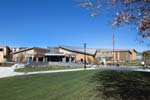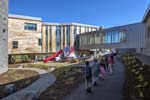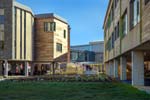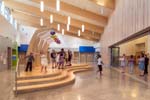
|

|
|
Home Site Search Contact Us Subscribe
|
|
Building Abundance Creating abundance is more than sustainability or resilience, and should be a driving force in architecture. By Edward McGraw, AIA, LEED AP BD+C October 18, 2018 Editor’s Note: This is the first in a series on abundance created and curated by Edward McGraw, AIA, LEED AP BD+C, founding partner and chief executive officer of Ashley McGraw Architects.
“Abundance” is not a word you might naturally associate with architects. But maybe it should be. Maybe it’s time to change the conversation and question how the built environment can coexist – and even enhance – the natural world around it. How can we, as architects, add to rather than take from nature?
This is something I’ve been investigating since hearing some of the pioneers of regenerative design speak at the Living Futures conference several years ago. Since then, designing buildings for abundance – not just for sustainability or resilience – has been a driving force in my practice.
Why now?
I write this in the wake of Hurricane Florence’s devastation of North and South Carolina, and the decimation of the Florida Panhandle and points north by Hurricane Michael. Once-in-a-generation storms now seem to happen regularly – we are in the midst of a “new normal.” Climate change is a reality and 97% of climate scientists say human behavior is to blame. Energy use in buildings is a key culprit, responsible for an estimated 40% of all carbon emissions in the United States; a 2013 MIT study attributes 200,000 early deaths annually to air pollution in the U.S.
The call to action has never been more urgent. As architects, we are in a unique position to make a positive impact on the environment. We have the power to design buildings that can “live” harmoniously in nature and that generate energy respectfully. Net zero energy buildings, for example, generate only the energy they use. Some even return excess energy to the greater power grid. Imagine the impact on our world if architects could persuade clients to build net positive buildings!
There is also a social equity component to building for abundance. Architecture is a manifestation of ecology, which studies how living things exist in their environments. We have an opportunity – an obligation – to help make those environments nurturing, comfortable, and safe for all people, rich or poor.
A shift in mindset
To really make an impact on the world around us, I believe we need to radically change the way we think about the built environment. Building for commercial advantage and respecting nature and energy are not mutually exclusive. The shift in thinking becomes how to do both to best advantage. How can architects take their knowledge of science and space to build abundance within natural systems?
At the start of each project, I like to ask, “How big is here?” to help define the scope and to better understand all of the systems that could impact – or be impacted by – whatever we’re designing. It’s one way to take into account all of the living systems, human and otherwise, that will interact in a project. Positioning what we do to both fit within and be of service to these multiple, nested systems requires an understanding of the patterns and interdependent relationships and requirements of these systems. In that way, the actions we take benefit the larger system relationships and ensure the long-term vitality of what we do. Every place we work is unique. The human and non-human stakeholders of the place need to be understood and included. Creating abundance entails respecting, celebrating, and leveraging those unique patterns and qualities.
The main shift is acknowledging that we are part of nature, not separate from it; you’re less likely to destroy or hurt something that is part of you. Understanding our important place within natural systems will help us identify where and how we can contribute to the long-term viability and evolution of these larger living systems. Contributing to the success of the larger system ensures our own abundance of opportunity. Projects are more likely to succeed when they are recognized as necessary for contributing to the success of the community, the economy, and the environment.
How to move forward?
There are immediate steps we architects can take to begin building abundance. One tool that I have found to be particularly valuable is the LENSES (Living Environments in Natural, Social, and Economic Systems) Framework for Regenerative Development, which we used in the planning phase of Nuthatch Hollow, a Living Building Challenge project for Binghamton University in New York. Following the LENSES framework, we conducted an on-site workshop that brought stakeholders together to identify key initiatives for the project through experiencing the site, developing guiding principles for decision making, and galvanizing an inspired vision for the future. The LENSES program was developed by CLEAR (Center for Living Environments and Regeneration).
Of course there are more immediate actions we can pursue. We can choose safe, non-toxic materials in projects. We can better understand where these materials come from, who makes them, how they’re made, and how these products impact people, communities, and economies up and down the supply chain. Another step is to learn about and incorporate aspects of permaculture and biophilia into our designs for all sectors, from multi-family to schools to civic buildings. And we can educate our clients about all of these processes and products.
I believe that a habitable future depends on mutually beneficial relationships between human-made and natural systems. If we're going to survive as a species and as a planet, we’ve got to get that right. It's something that's far larger than architecture; it drives how we live, how we think, how we practice our craft.
Ed McGraw, AIA, LEED AP BD+C, is founding partner and chief executive officer of Syracuse-based Ashley McGraw Architects. He is a nationally recognized authority on sustainability and high-performance buildings, and speaks frequently on the subject. Among the organizations he has addressed are the American Institute of Architects National Convention, Northeast Sustainable Energy Association, New York State Green Building Conference, Council of School Superintendents, and School Boards Association, and the Eastern Region of the Association of Physical Plant Administrators. He holds a Master of Architecture degree from Syracuse University and a bachelor’s degree in business from SUNY Binghamton. |
(click on pictures to enlarge)  Ashley McGraw Architects Ashley McGraw Architects is designing Nuthatch Hollow, an environmental classroom and research facility for Binghamton University in New York. The design team is aiming for both Living Building Challenge and Passive House certification.  Ashley McGraw Architects Nuthatch Hollow will be a building with net positive energy, net positive water, red list-compliant materials, extreme reductions in energy use and load, super insulation, and super air-tightness.  John Griebsch Photography After the existing MacArthur Elementary School in Binghamton, NY, was destroyed by flooding in 2011, Ashley McGraw Architects designed a new school that is deeply sustainable and resilient.  John Griebsch Photography Ashley McGraw created an inclusive and interactive process to engage all stakeholders in the design of the new school.  John Griebsch Photography Rain gardens, bio-swales, and indigenous vegetation are used to treat water on site, and demonstrate and teach about the hydrological cycle of the site.  John Griebsch Photography Three 2 -story classroom wings are raised on columns to allow the river to flood and recede naturally over time.  John Griebsch Photography Recognizing that learning can happen anywhere at anytime, Ashley McGraw’s design of MacArthur Elementary includes opportunities for “third space learning.” |
© 2018 ArchNewsNow.com